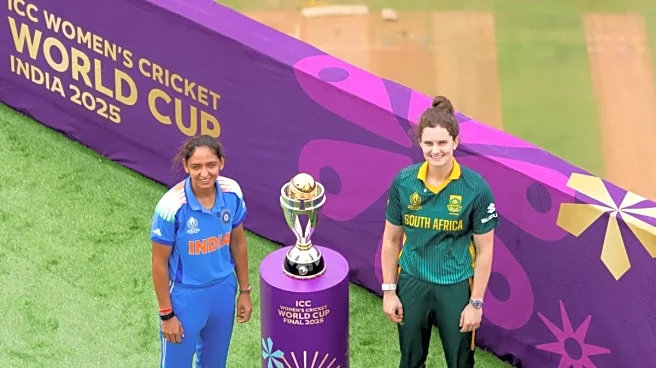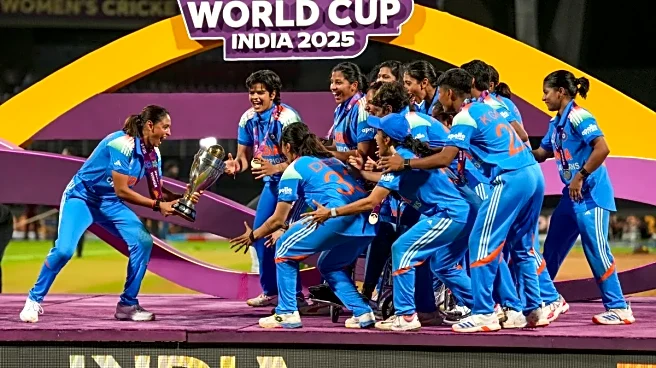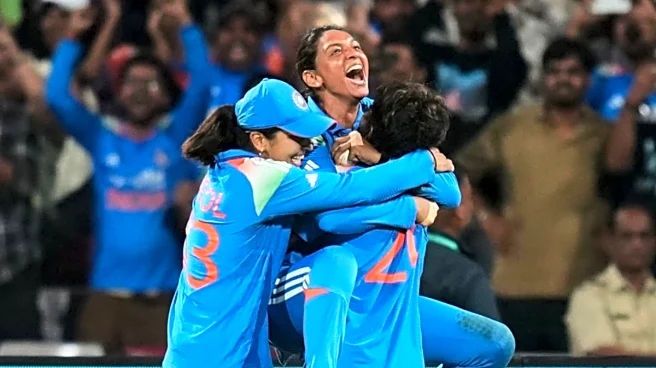New Delhi, Nov 4: The night of November 2, 2025, will forever be etched in Indian sporting history. Under the dynamic leadership of Harmanpreet Kaur, the Indian women's cricket team lifted the ICC Women's
Cricket World Cup 2025, scripting a moment of redemption and glory that transcended generations.
The emphatic 52-run victory over South Africa at the DY Patil Stadium in Navi Mumbai not only crowned India as world champions for the first time in the women's 50-over format but also strengthened the country's stature as a global cricketing powerhouse.
With this monumental triumph, India's total tally of ICC titles across men's, women's, and U19 categories now stands at 15, putting them firmly in second place in the all-time ICC trophy leaderboard - behind only Australia, who lead with 27 titles.
Most ICC Trophies (Men's + Women's + U19)
- Australia - 27
- India - 15
- England - 9
- West Indies - 7
- Pakistan - 5
- New Zealand - 4
- Sri Lanka - 3
- South Africa - 3
- Bangladesh - 1
A Defining Moment in India's Cricketing Journey
The World Cup win was more than just a trophy - it was a culmination of years of progress, resilience, and evolution in Indian women's cricket. Led by Harmanpreet Kaur and powered by standout performers like Smriti Mandhana, Shafali Verma, Deepti Sharma, and Renuka Singh, Team India displayed an unmatched blend of aggression, maturity, and unity throughout the tournament.
The 52-run win in the final against South Africa was symbolic - a commanding performance that reflected not only the team's cricketing growth but also the maturity of a sporting ecosystem that has begun to give women's cricket the recognition it deserves.
As fireworks lit up the Navi Mumbai sky and fans celebrated across the country, the victory also brought an emotional sense of closure to a long wait - ending decades of near misses and heartbreaks on the global stage.
Closing the Gap on Australia
For years, Australia have dominated world cricket, setting records across both men's and women's formats. But India's continued rise, marked by global triumphs across formats, signals a new era of competition.
From Kapil Dev's 1983 World Cup victory to MS Dhoni's 2007 T20 World Cup and 2011 ODI World Cup triumphs, and now Harmanpreet Kaur's 2025 Women's World Cup win, India's cricketing story has come full circle - unified under a legacy of excellence.
The addition of multiple U19 World Cup titles further reflects the depth of India's cricketing talent pool and the strength of its developmental structures.
Women's Cricket: From Hope to History
India's women's team had come close before - notably in 2005 and 2017, when they finished runners-up - but 2025 marked the ultimate breakthrough. This triumph wasn't just about lifting a cup; it was about rewriting the narrative.
The victory also comes at a time when women's cricket is experiencing exponential growth, with the Women's Premier League (WPL) acting as a platform for players to gain exposure, experience, and financial stability. The World Cup success is expected to create a new wave of participation and investment in the women's game - from grassroots academies to professional leagues.
"This is not just our victory - it's a victory for every young girl who dared to dream," said skipper Harmanpreet Kaur after the win. "We've waited a long time for this, and today we've shown that Indian women's cricket belongs among the world's best. "
A Nation United by Cricket
The 2025 triumph reaffirms cricket's unparalleled role in uniting India - across gender, regions, and generations. From fans flooding streets with tricolour flags to spontaneous celebrations at academies and local grounds, the victory resonated as deeply as India's past men's World Cup triumphs.
India's dominance now spans every level of the game - men's, women's, and youth - a testament to the country's growing investment in infrastructure, talent development, and mental conditioning programs.
With 15 ICC titles to their name, India may still trail Australia in numbers, but in terms of emotion, reach, and cultural impact, they remain second to none.












